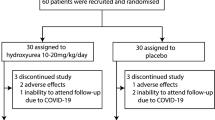Abstract
Pharmacological agents such as hydroxyurea (HU) have been known to cause induction of fetal hemoglobin and possibly may alleviate the symptoms in thalassemia intermedia patients. Thirty-seven patients with β-thalassemia intermedia were enrolled to assess response to HU therapy. Major response was defined as transfusion independence or hemoglobin rise of more than 20 g/l and minor response as rise in hemoglobin of 10–20 g/l or reduction in transfusion frequency by 50%. The median age was 10 years (range: 4–50 years) and median follow-up was 12 months (range: 4–36 months). Twenty-six patients (70.2%) showed response to HU therapy. Seventeen patients (45.9%) were major responders, and nine patients (24.3%) showed minor response. There was no correlation of response with β-thalassemia mutation or XmnI polymorphism; however, the presence of α3.7 deletion was associated with major response in three patients. Mean fetal hemoglobin (HbF) levels rose on HU therapy. Older age, low baseline F cell percent, and low baseline HbF levels (below 10%) were predictors of poor response. Response was evident within 1 month of starting HU therapy in the majority of responders. Thus, a short trial of HU therapy can predict durable response.
Similar content being viewed by others
References
Higgs DR, Thein SL, Woods WG (2001) The physiology of the thalassemias. In: Weatherall DJ, Clegg B (eds) The thalassemia syndromes, 4th edn. Blackwell, Oxford Science Ltd., pp 265–284
Winichagoon P, Thonglairoam V, Fucharoen S, Wilairat P, Fukumaki Y, Wasi P (1993) Severity differences in beta-thalassaemia/haemoglobin E syndromes: implication of genetic factors. Br J Haematol 83:633–639
Olivieri N (1996) Reactivation of fetal hemoglobin in patients with beta-thalassemia. Semin Hematol 33:24–42
Dacie JV, Lewis SM (2001) Practical haematology, 10th edn. Churchill Livingstone, Edinburgh
Charache S, Terrin MI, Moore RD et al (1995) Effect of hydroxyurea on frequency of painful crisis in sickle cell anemia. Investigators of the Multicenter Study of Hydroxyurea in Sickle Cell Anemia. N Engl J Med 332:1317–1322
Atweh GF, Loukopoulos D (2001) Pharmacological induction of fetal hemoglobin in sickle cell disease and β-thalassemia. Semin Hematol 38:367–373
Choudhry VP, Lal A, Pati HP, Arya LS (1997) Hematological response to hydroxyurea therapy in multitransfused thalassemic children. Indian J Pediatr 64:395–398
Bradai M, Abad MT, Pissard S, Lamraoui F, Skopinski L, de Montalembert M (2003) Hydroxyurea can eliminate transfusion requirements in children with sever beta-thalassemia. Blood 102:1529–1530
de Paula EV, Lima CSP, Arruda VR, Alberto FL, Saad STO, Costa FF (2003) Long term hydroxyurea therapy in beta thalassemia patients. Eur J Haematol 70:151–155
McDonagh KT, Orringer EP, Dover GJ, Ninhuis AW (1990) Hydroxyurea improves erythropoiesis in a patient with homozygous beta-thalassemia. Clin Res 38:346A
Arruda VR, Lima CSP, Saad STO, Costa FF (1997) Successful use of hydroxyurea in β-thalassemia major. N Engl J Med 336:964
Hajjar FM, Pearson HA (1994) Pharmacological treatment of thalassemia intermedia with hydroxyurea. J Pediatr 125:490–492
Loukopoulos D, Voskaridou E, Stamoulakatou A et al (1998) Hydroxyurea therapy in thalassemia. Ann N Y Acad Sci 850:120–128
Saxon BR, Reeds D, Olivieri NF (1998) Regression of extramedullary haemopoiesis and augmentation of fetal haemoglobin concentration during hydroxyurea therapy in beta thalassaemia. Br J Haematol 101:416–419
Styles L, Lewis B, Foote D, Cuca L, Vichinski E (1998) Preliminary report: hydroxyurea produces significant clinical response in thalassemia intermedia. Ann N Y Acad Sci 850:461–462
Hoppe C, Vichinski E, Lewis B, Foote D, Styles L (1999) Hydroxyurea and sodium phenylbutyrate therapy in thalassemia intermedia. Am J Hematol 62:221–227
Tsiarta H, Pavlidids N, Voskaridou E (1999) Treatment of thalassemia intermedia with hydroxyurea. Blood 94:3309
Cianciulli P, Di Toritto TC, Sorrentino F, Sergiacomi L, Massa A, Amadori S (2000) Hydroxyurea therapy in paraparesis and cauda equina syndromes due to extramedullary haematopoiesis in thalassaemia: improvement of clinical and haematological parameters. Eur J Haematol 64:426–429
El Alfy MS, Tantawy AAG (2000) One year pilot trial of hydroxyurea in transfusion dependent β-thalassemia intermedia. Blood 96:3759
Zeng YT, Huang SZ, Ren ZR et al (1995) Hydroxyurea therapy in beta-thalassaemia intermedia: improvement in haematological parameters due to enhanced beta-globin synthesis. Br J Haematol 90:557–563
Author information
Authors and Affiliations
Corresponding author
Rights and permissions
About this article
Cite this article
Dixit, A., Chatterjee, T.C., Mishra, P. et al. Hydroxyurea in thalassemia intermedia—a promising therapy. Ann Hematol 84, 441–446 (2005). https://doi.org/10.1007/s00277-005-1026-4
Received:
Accepted:
Published:
Issue Date:
DOI: https://doi.org/10.1007/s00277-005-1026-4




